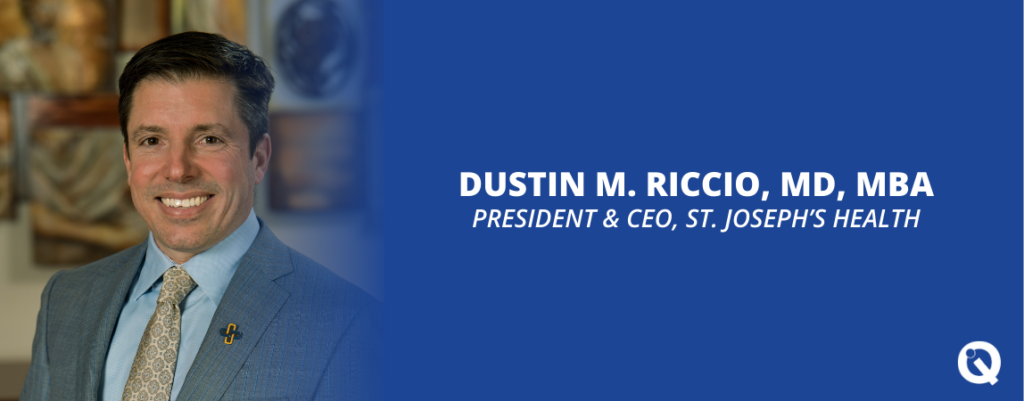St. Joseph’s Health is a member of the Quality Institute’s Provider Council, System Level.
You originally are from New Jersey, but most recently worked in leadership and clinical positions (as an emergency medicine physician) at Rochester Regional Health. What drew you back to New Jersey?
I started my health care administrative journey back in 2010. As I moved throughout the various roles, including as president of other organizations, I was always keeping an eye on what was happening back in Jersey. The state is a highly competitive health care environment. I have sought for quite some time to be a part of that. I thought about what I could offer back to the state where I grew up.
What are your top priorities in this new position? Can you share one or two?
A top priority is engaging the employees here at St. Joe’s. When I first walked into St. Joe’s, I felt this strong sense of culture, which is grounded in the individuals who have been here for many decades. We have people who have been working here for 10, 20, 30, 40 years, and they continue to share in this tangible and special culture. Re-engaging our staff in a very challenging health care environment is something that I’m very passionate about. I appreciate what administrators do, but, as a clinician, I understand the work that’s happening is on the front line.
Creating a patient experience that is second-to-none is a priority. An engaged employee within a health care organization is what drives that patient experience. We want to make sure that people know who we are and what we do as a function of the experience they have at any one of our acute care facilities or outpatient sites.
Creating and sustaining our health care workforce is a continual challenge. What is St. Joseph’s Health doing to attract and retain health care team members?
Being a clinician myself as an emergency medicine physician has given me valuable insight into all aspects of the inpatient and outpatient areas of focus for a health care system. What I want to do is to build a strong culture by removing barriers to success for our clinical staff. I believe that gets people back to the basics of why they got into health care: caring for their communities and providing for their families.
It’s also about retaining the quality people we have and implementing a recruitment strategy. We want people to say, “I know what St. Joe’s is right now and what Dr. Riccio wants to do moving forward — and I want to be a part of that.” It’s employee engagement, patient experience, and it’s quality, safety, and clinical recruitment.
Your health care organization is a large provider of care for women and children. There were 3,201 births at St. Joseph’s University Medical Center last year. What initiatives to improve outcomes are showing real impact?
Some of our great work has been focused around advancing health equity and access to maternal and child health, namely with our Centering Pregnancy program. The program offers mothers a unique way to experience prenatal care by bringing them out of the traditional exam room and into a comfortable group setting to engage with trained staff and build community. It’s a key initiative that has improved a number of benchmarks around breastfeeding, postpartum visits, and Cesarean rates.
Finally, we like to ask a question beyond a person’s professional work. If you could choose anyone (throughout history or alive today), who would be your hero?
I could pick a number of different historical figures, but I have one picture in my office, and one picture only, and it’s of my grandfather. He’s somebody who embodied humility and leadership. I think of him as aggressive and kind all at the same time. He was a hero in the Battle of the Bulge in World War II, and then came back to do great work here in Hudson County, New Jersey. He’s somebody that I’ve always looked up to. Unfortunately, he passed away at an early age and I never got to know him as well as some other people did. But I am just as fascinated with his legacy and he’s somebody that I lean on more than any other historical or current figure.

